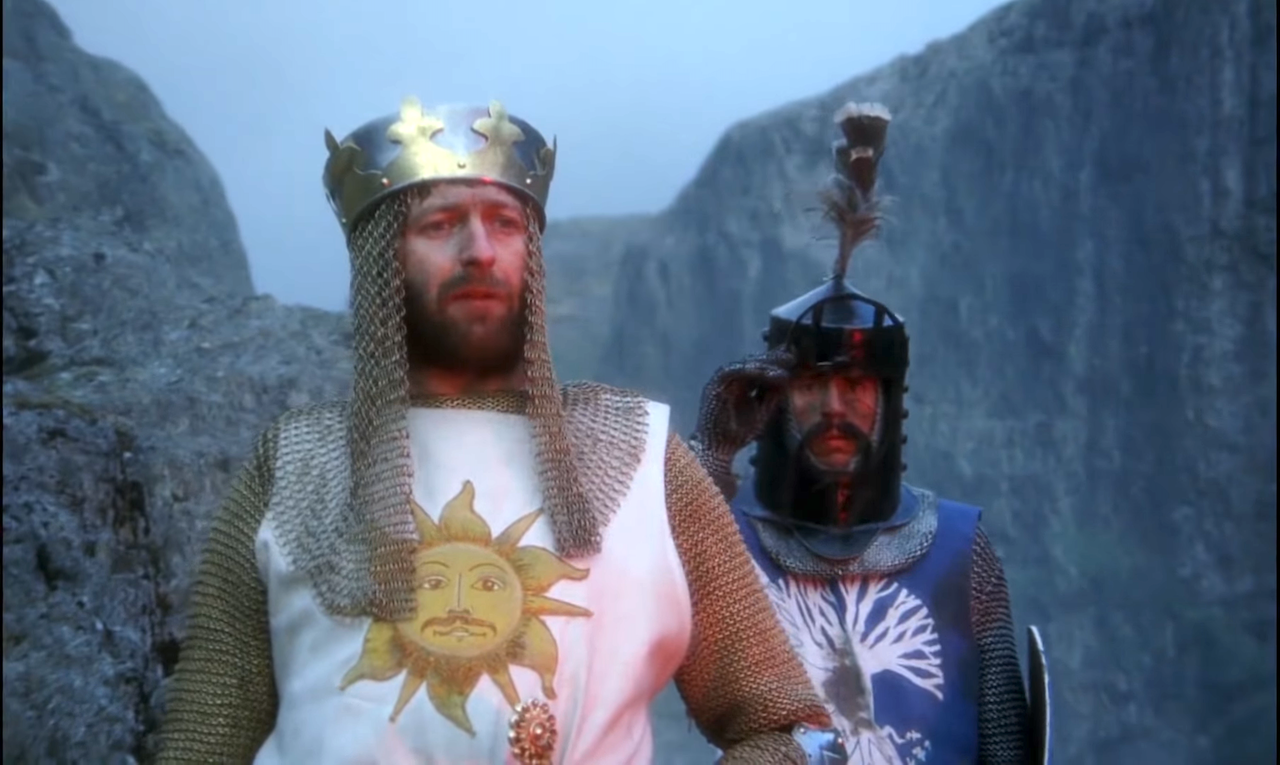Moving Pictures is quoted as saying that Mise-En-Scene is “referring to every element in the frame that contributes to the overall look of a film.” (Sharman 64) Moving Pictures says that the elements of a film that continued to Mise-En-Scene are set design, costume, hair, make-up, color scheme, framing, composition, and lightning. A typical set design might be just a simple house that you might see in your neighborhood but something extreme could be a house of a might only be seen in certain regions like the house Bilbo Baggin’s house from The Hobbit was based on. Most movies past 1960 are shot in color, but some and very few movies are made in black and white for stylistic reasons the “The Lighthouse” in 2019. Most of the aspects of Monty Python and the Holy Grail are pretty standard in terms of Mise-En-Scene. The costumes look good, lighting is pretty standard as the movie uses natural lighting for most of the film, the only aspect of Mise-En-Scene that the film uses that’s interesting is its use of props. The coconut prop in place of an actual horse is the film’s most famous gag.
Moving Pictures compares actors to athletes, “They spend a lifetime training, perfecting their technique, honing their bodies to be the perfect instrument of their craft.” (Sharman 218) Moving Pictures says that the perfect performance is more than the sum of its parts, like lightning in a bottle. The acting in Monty Python and the Holy Grail is exaggerated and stylized, yet typical for the comedy genre. The scene where the joke is the character’s reactions to the insanity of the film are overdramatic and that makes it funny. One scene that I find the actor very funny in is when King Arthur talks to the rude Frenchman at the top of the castle. The mere absurdity of the scene compared to the other scenes in the film makes the acting very comedic. The actors start using words not commonly used in a fantasy or medieval setting, like “weight ratios” and “airspeed velocity” https://www.youtube.com/watch?v=H4_9kDO3q0w
The Cinematography of Monty Python and the Holy Grail is somehow both typical and atypical at the same time. Monty Python is typical in the fact that the coloring and scenery of its scenes match its genre, but atypical because of the fact that it changes genres almost every ten minutes. For scenes that give an adventure vibe, we have shots of King Arthur slowly approaching for faraway on a hillside or similar scenery. But when the genre changes to something like a documentary, the shot type also changes to make the new genre. When the scene is a documentary, we see a pull-out shot of a historian, which matches the new documentary genre. When the genre shifts into the horror genre the color scheme goes into very dark and muted colors with shots of either extreme close-ups or far-away shots, to either match the feelings of claustrophobia or extreme loneliness
The very low budget of Monty Python and the Holy Grail brought a lot of smart usage of special FX. A vast amount of the special FX is used to make jokes. And the FX look is not realistic at all and that makes it a lot more fun. The stop motion god they use for scenes looks like a puppet and it adds the absurdity of the joke. Most of the effects in the movie are practical effects. The giant 9 something foot forest guardian could have just as well been done with special effects, but due to the budget, it’s multiple people standing on top of each other. The FX of the movie is mostly camera trickery, the french guard yelling at King Arthur and his knight isn’t actually standing on the top of the castle, it’s a separate shot of the french guard standing in a cutout of the castle. The scene where a castle is in the background it’s just a cut-board cutout, they even say so in the film “it’s only a model”
Nearly every function of Monty Python and the Holy Grail is there to be funny and entertaining. The performances are over-exaggerated for the sake of humor, the cinematography also serves to complement the current genre the film is in, the playoff the contrast of a genre shift. The FX are such bad quality and it’s humorous and plays off the rest of the lack of budget. The narrative of the film is constantly being convoluted to add to the confusion of the audience that the movie used to be humorous. The narrative is supported by the psychological aspects of the audio that also confuse the audience, such as the sounds of power tools in what we can assume to be the 5th or 6th century. One scene I enjoyed was Lance-a-lot running towards a castle and it would cut back and forth between the guards and Lance-a-lot. Every time the scene cuts back to lance-a-lot its the same shot of him running up a hill so when it cuts directly to Lance-a-lot stabbing the guard, it makes no sense but you can’t help but laugh

